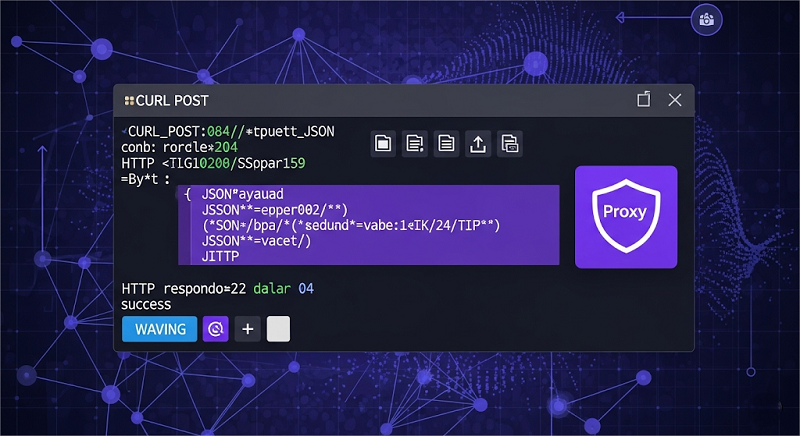Ultimate Guide for cURL POST Requests
HTTP POST greatly empowers form submissions, API calls, file uploads, and automation scripts. Whether you’re testing an API or integrating with a web service, understanding how to craft robust cURL POST requests—and troubleshoot them—is essential. In this guide, you’ll learn everything from basic syntax to advanced techniques, including how to route your requests through proxies for reliable, geo‑flexible access.

Why Use cURL for POST Requests?
For Beginners
No GUI Needed: You can send requests directly from a terminal—no code editor or browser required.
Instant Feedback: See headers, status codes, and body all at once.
For Advanced Users
Scripting & Automation: Embed cURL commands in shell scripts or CI pipelines.
Protocol Agnostic: Beyond HTTP/S, cURL supports FTP, IMAP, SMTP, so you can reuse familiar syntax for diverse tasks.
Proxy & TLS Control: Fine‑tune TLS versions, ciphers, and proxy chains for penetration testing or load balancing.
Installing cURL (For Absolute Beginners)
| OS | Command |
| Linux | sudo apt install curlsudo yum install curl |
| macOS | brew install curl |
| Windows | Chocolatey: choco install curlWinGet: winget install curl |
Tip for Pros: Install the latest cURL via source to get cutting‑edge flags like --json before your package manager does.
Check your version to ensure support for newer flags like --json:
bash
curl --version
Basic cURL POST Syntax
bash
curl -X POST [options] [URL]
| Option | Purpose |
| -X POST | Specify HTTP method (optional if using -d or -F) |
| -H / --header | Add/override request headers (e.g., Content-Type, Accept) |
| -d / --data | Send inline data or load from file (@filename) |
| --json | (v7.82+) Auto-sets JSON headers and escapes payload |
| -F / --form | Send multipart/form-data (ideal for file uploads) |
| -i | Include response headers in the output |
| -v | Verbose mode—details every step of the request for debugging |
Beginner Tip: If you forget -X POST, cURL will default to GET unless -d or -F is supplied, in which case it switches to POST automatically.
Sending JSON Payloads
1. Define the endpoint
bash
API_URL="https://api.example.com/users"
2. Create JSON data
bash
JSON='{"firstName":"Alice","lastName":"Jones","email":"[email protected]"}'
3. Send the request
bash
curl -X POST \
-H "Content-Type: application/json" \
-d "$JSON" \
"$API_URL"
Why quotes matter
On UNIX shells, wrap the entire JSON in single quotes so you don’t have to escape double‑quotes inside.
Advanced Usage
Use --json (curl ≥ 7.82) to simplify:
bash
curl --json "$JSON" "$API_URL"
Pretty‑print JSON responses by piping through jq:
bash
curl --json "$JSON" "$API_URL" | jq .
Chunked transfer for large payloads:
bash
curl -H "Transfer-Encoding: chunked" --data-binary @large.json "$API_URL"
Routing via OkeyProxy
Test API behavior from different regions or bypass IP-based rate limits.
bash
curl -x proxy.okeyproxy.com:8000 \
-U "user:pass" \
--json "$JSON" \
"$API_URL"
Submitting Form-URL Encoded Data
Forms on the web use application/x-www-form-urlencoded. To mimic:
bash
curl -d "username=alice&password=secret123" \
https://app.example.com/login
Multiple fields:
bash
curl -d "field1=value1" -d "field2=value2" https://…
Pro Tip: Use --data-urlencode to automatically percent‑encode special characters:
bash
curl --data-urlencode "search=hello world?" https://…
File Uploads with Multipart/Form-Data
When you need to send files (images, CSVs):
bash
curl -F "profileImage=@/path/to/avatar.jpg" \
-F "userId=42" \
https://api.example.com/upload
Stream large files without buffering locally:
bash
curl -F "file=@/path/to/huge.bin;type=application/octet-stream" https://…
Editor’s Tip: Throttle upload speed using --limit-rate 500k.
Advanced Data Flags
| Flag | Use Case |
| --data-binary | Preserve exact content, including CR/LF in files |
| --data-raw | Send data literally—even if it starts with @ |
| -G + --data | Send data as URL query parameters with GET |
Binary payload example:
bash
curl --data-binary @payload.bin https://stream.api.com/ingest
Authentication Essentials
Basic Auth:
bash
curl -u "user:pass" \
--json '{"action":"ping"}' \
https://secure.api.com/ping
Bearer Tokens:
bash
curl -H "Authorization: Bearer YOUR_TOKEN" \
--json '{"data":42}' \
https://api.example.com/data
OAuth2 Client Credentials:
1. Obtain token:
bash
curl -X POST -d "grant_type=client_credentials" \
-u "client_id:client_secret" \
https://auth.server.com/token
2. Use token:
bash
curl -H "Authorization: Bearer ACCESS_TOKEN" https://…
Troubleshooting Common Pitfalls
| Issue | Explanation & Fix |
| 415 Unsupported Media Type | Wrong Content-Type. Match it to your payload (application/json) |
| Trailing Newlines | Use --data-binary to preserve exact content |
| Quote Escaping | On Windows, double-quote and escape " as \"; on UNIX, use single quotes |
| Proxy Errors | Confirm -U credentials or try --proxy-user |
| Redirect Loops | Add -L to follow redirects |
Best Practices & Performance Tips
1. Silent & Safe: -sS --fail to hide progress but show errors.
2. Timeouts: --connect-timeout 5 --max-time 30 to avoid hangs.
3. Capture Output:
- -o response.json for full body.
- -w "%{http_code}\n" for only status.
4. Rate‑Limit: --limit-rate to throttle speed.
5. Proxy Rotation: Automate IP rotation with OkeyProxy for large‑scale scraping or load testing.
Conclusion
cURL POST requests are foundational for web integration, whether you’re a newcomer or a seasoned dev. You now have a clear path—from installation and basic syntax to advanced flags, authentication flows, and proxy routing with OkeyProxy. Bookmark this guide, and you’ll be ready to tackle any HTTP POST scenario with confidence.























